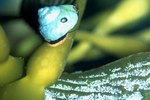
Sometimes in nature, animals will work together for their mutual benefit. In the waters off Hawaii, the yellow tang and the green sea turtle have such a relationship. These animals work together in ways that benefit each other, a type of interaction called symbiosis or mutualism.
Feeding Stations
Yellow tangs (Zebrasoma flavescens) are bright yellow fish that eat algae. Off the shores of Hawaii, they group together, sometimes with other species of fish, to form "feeding stations." At these feeding stations, yellow tangs wait for green sea turtles (Chelonia mydas), to come by for a cleaning. Once a turtle arrives, tangs and other fish eat algae and parasites off the turtle's skin, cleaning the shell.
What the Tang Gets
Both the tang and the turtle benefit from these cleanings. First and foremost, the tang gets a meal out of the arrangement. Yellow tangs need to eat algae, and lots of it, to survive. The green sea turtles provide a rich meal in one convenient spot. This saves the tang energy since it doesn't have to go out foraging for food. It also means that the tangs do not have to run the risk of stumbling across predators while grazing on the reef.
What the Turtle Gets
Meanwhile, the sea turtle also receives benefits from this arrangement. First, these cleanings make the shell more smooth. This reduces friction with the water and makes it easier for the turtle to swim. Second, fish at the cleaning stations will make a meal out of external parasites on the turtle. This improves the turtle's health, and all it had to do was swim up to the cleaning station.
Types of Symbiosis
There are several kinds of symbiosis observed in nature. In all types of symbiosis, one organism gains benefit from another. The relationship between yellow tangs and green sea turtles is an example of a type of symbiosis called "mutualism." In mutualism, both organisms receive benefits from their relationship. This contrasts with commensalism -- where only one organism receives benefits, while the other is not harmed or hurt -- and parasitism, where one organism gains from the relationship at the expense of the other.
References
- National Geographic: Best Wildlife Photos of 2006 Announced,
- FishChannel.Com:Yellow Tang Fish
- NOAA Office of Protected Resources: Green Turtle (Chelonia mydas)
- Britannica Online: Symbiosis (Biology)
- Britannica Online: Mutalism (Biology)
- Fishbase: Ctenochaetus strigosus
- Animal Diveristy Web: Thalassoma bifasciatum
Photo Credits
-
Stockbyte/Stockbyte/Getty Images




